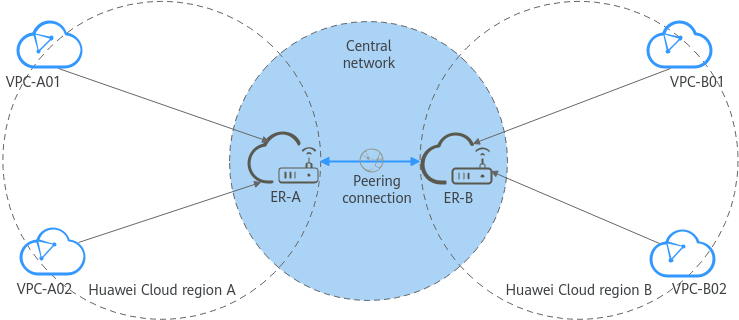Overview
Central Network
Relying on the cloud backbone network, a central network allows you to easily set up a reliable, intelligent enterprise-grade network and manage global network resources on premises and on the cloud. By setting up a central network, you can enable communication between enterprise routers, as well as between enterprise routers and your on-premises data center, in the same region or different regions.
Application Scenarios
- Cross-region communication on the cloud: Enterprise routers in different regions are added to a central network as attachments so that resources in these regions can communicate with each other over one network.
Figure 1 Cross-region communication between enterprise routers

- Communication between on-premises data centers and the cloud: Enterprise routers and global DC gateways are added to a central network as attachments. In this way, multiple VPCs on the cloud can communicate with on-premises data centers across regions.
Figure 2 Connectivity between enterprise routers and an on-premises data center

- Global network: By flexibly changing the central network policies, you can build a global network more conveniently.
Central Network Quotas
|
Quota Type |
Default Quota |
Adjustable |
|---|---|---|
|
Central networks in an account |
6 |
Yes |
|
Policies for a central network |
500 |
Yes |
|
Policy document size (KB) |
10 |
No |
|
Enterprise routers on a central network as attachments in a region |
1 |
No |
|
Global DC gateways on a central network as attachments in a region |
3 |
Yes |
Constraints on Central Networks
- To use a central network, the following resources must have been created:
- Enterprise router: used to build a central network
- Global DC gateway: attached to an enterprise router for allowing on-premises data centers to access the cloud across regions
- Policy management
- A central network can only have one policy. If you apply another policy for this central network, the policy that was previously applied will be automatically cancelled.
- In each policy, only one enterprise router can be added for a region. All added enterprise routers can communicate with each other by default.
- A policy that is being applied or cancelled cannot be deleted.
- Cross-site connection bandwidth management
- A cross-site connection bandwidth cannot be changed or deleted when it is being created, updated, deleted, frozen, unfrozen, or is recovering.
- The total of cross-site connection bandwidths cannot exceed the global connection bandwidth.
- If a cross-site connection bandwidth is deleted, you will still be billed for the global connection bandwidth.
Configuration Process
Figure 3 shows the process of configuring a central network to manage global network resources.
|
No. |
Step |
Description |
Reference |
|---|---|---|---|
|
1 |
Create a central network. |
After an enterprise router is created, you can create a central network and add the enterprise router to a policy of the central network. In this way, resources can communicate with each other across regions, and network resources in each region can be managed centrally. |
|
|
2 |
(Optional) Add attachments. |
Attach global DC gateways to the enterprise routers in a specific region of the central network to enable resources to communicate with each other across regions. |
|
|
3 |
Assign a cross-site connection bandwidth. |
After adding enterprise routers or global DC gateways in different regions to the same policy, purchase a global connection bandwidth and assign bandwidths for cross-site connections. |
Feedback
Was this page helpful?
Provide feedbackThank you very much for your feedback. We will continue working to improve the documentation.See the reply and handling status in My Cloud VOC.
For any further questions, feel free to contact us through the chatbot.
Chatbot







